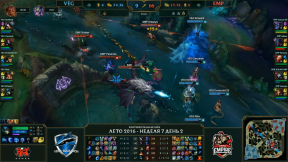Strategic marketing - course 260,000 rub. from HSE, training 6 months, Date: November 9, 2023.
Miscellaneous / / November 29, 2023
Peter Drucker said: “Business has two (and only two) main functions: marketing and innovation.” The Strategic Marketing program is for those who are responsible for the most important things in companies.
We will discuss pressing issues and problems in discussions in order to adopt the best practices of the professional community. We will solve real business cases.
The training is organized in a modular format. Face-to-face modules take place once a month and last three days. Between modules, you will find homework, online sessions with experts, workshops on individual projects, and work on your project under the guidance of a tutor.
01
Strategic view of the company's marketing function
02
Proficient in tools for managing marketing in a digital-physical environment
03
Ready-to-implement marketing strategy
The full cost of training for the Strategic Marketing program is 260,000 rubles.
Payment in one lump sum or in three equal installments using bank details or at the HSE cash desk at St. Petersburg, st. Printers' Union, d. 16. Please note that payment must be made no later than 12 calendar days before the start date of training.
Teacher of the discipline “Marketing Communications”. Chief expert of the Institute of Further Professional Education of the National Research University Higher School of Economics - St. Petersburg.
Strategic Marketing Environment
The place of marketing strategy in the overall strategy of the company.
Modern systems approach to strategy: holarchy of systems, stakeholders, life cycle of systems 2.0. Company like using system, strategy as a target system, strategic vision as functional requirements for the target system.
How to develop a strategy?
Modern practices of identifying the interests of external and internal stakeholders, strategic analysis of the external environment and internal resources, strategizing and business modeling. Description of the strategy as a target system: the sum of change projects and current operational activities in the interests of stakeholders.
How to implement the strategy?
Modern practices of managing work to implement the strategy. Principles of managing the life cycle of a strategy as a target system.
Workshop: How to identify requirements for a marketing strategy from the overall strategy of the company?
As a result of completing the course, students will learn:
- see the company as a system aimed at satisfying the interests of stakeholders
- select methods (practices) to develop the overall strategy of the company
- select methods (practices) for implementing strategy in a company, understand the principles of strategy life cycle management
- distinguish marketing strategy from the overall company strategy
Marketing strategy implementation management
- Marketing strategy as a portfolio of projects.
- Classic approach to project management. Project life cycle, “Gateways” between stages.
- Agile as a tool for implementing marketing projects. The cycle “idea - development - testing - evaluation”. Coordination of project participants,
- Leveling the workload of employees.
- Why don’t agile technologies replace the need for a classic project? Budget management for agile projects.
- Project risk management.
Workshop: Planning and managing a marketing project using User Stories and Kanban boards.
Financial assessment of marketing
At the end of the course, students will understand the following issues:
- How to make informed management decisions aimed at increasing business efficiency. To do this, we will understand financial reporting and break-even, the role of these concepts in making management decisions.
- How does competent marketing influence increasing company revenue?
- What is money depreciation over time and why is it important to generate money now?
- How to prepare a financial model for making investment decisions, analyze the potential risks of projects and calculate their performance indicators. To do this, we will get acquainted with the criteria for making investment decisions, forecasting methods and risk management models
Behavioral economics. Psychology of consumer decision making
The Source of Error: What's Wrong with the Human Economic Model
Is it possible to predict the behavior and choices of other people? Game theory and “invisible” forces. Factors of strategies “outside the brackets” of the economic model: what and why behavioral economics studies. The power of the situation: reciprocity, conformity, context and rationalization. Moral implications of markets: prices and values, consumer and citizen. Social brand equity: a course towards ethics.
Examples and work on the case.
The human brain and choice under uncertainty
How our brain works and how we make decisions. Intuition vs. Rational Judgment: System 1 and System 2. Solutions in “hot” and “cold” states. Cognitive heuristics, intuition and automatisms: choice paralysis and the power of the “default option”, framing of alternatives and “Prospect Theory” D. Kahneman, heuristics as a shortcut to “instant” decisions. Multiple selves and mechanisms of influence on choice.
NUDGE as a “choice architecture” tool
Why is choice architecture inevitable? Nudging is an alternative to strict regulation and complete freedom of choice. Nudge – manipulation or help? The principle of libertarian paternalism. Save More Tomorrow - how nudging helped solve the problem of insufficient pension savings in the United States. EAST methodology from Behavioral Insights Team (“Nudge Unit)[1] (cases). 7 Types of Nudges Based on the Principles of Social Influence and Cognitive Decision Making Mechanisms.
Workshop: Working with cases using Nudge techniques
Getting customer insights from data
The course will examine the most effective methods for analyzing order/purchase history in order to increase sales/profits. The necessary initial information for customer analytics is already at the disposal of any company, does not require additional costs to collect, and at the same time has enormous hidden potential.
The course will include 4 main blocks:
- The most important types of graphs and tables for analyzing key customer analytics indicators in general and across cohorts.
- Market Basket Analysis/Association Rules Mining to identify ways to increase cross-sales.
- Segmentation of the client base using the RFM (Recency-Frequency-Monetary) method and cluster analysis methods.
- Predictive and prescriptive analytics using machine learning methods (predicting customer value, modeling the likelihood of customer churn, identifying driving forces for repeat purchases).
Students will gain an understanding of the possibilities of analyzing transaction data and will be able to set clear tasks for specialists in the field data analysis, and will also learn to interpret the output results from the point of view of making strategic decisions. Also, students will be provided with numerous examples of real data analysis, including initial data, the program code used to process it and the reports prepared based on the received results.
Methods of quantitative and qualitative research of the target audience
Qualitative Research
Problems solved using qualitative research. Defining the problem and objectives of your projects. Key parameters of qualitative research. In-depth interviews, sampling in in-depth interviews. Features of interaction with the respondent during an in-depth interview. Advantages of focus groups, tasks solved with the help of focus groups. Features of the research design when conducting focus groups. Other qualitative research methods: ethnography, observation and guided visit. Drawing up a guide and screener, examples of questions, guides that solve a particular research problem. Projective techniques. Analysis of qualitative research results. Identifying insights. Presentation of results in a report. Features of interaction with research contractors and their pricing.
Quantitative Research
Types of research to study a new and current product. Quantitative research methods, advantages and disadvantages of each method. Sample: number of respondents and what is important to know about the features of its construction. U&A research: key purpose of the study, areas to be studied within the study. Discussion of the structure and set of sample U&A survey questions, sample questions and questionnaires that could be included in this study. Product/packaging/advertising materials concept test: rules for writing a product concept description, key KPIs, when they are used, additional metrics for testing. Price research, advertising effectiveness. Data analysis. Interpretation of data, interpretation errors. Data visualization, examples of successful and unsuccessful data visualization.
Workshop 1: Analysis of qualitative research results
Workshop 2: Development of a questionnaire for quantitative research
As a result of completing the course, students will learn:
- Choose the appropriate research method depending on the tasks
- Conduct qualitative research independently
- Conduct quantitative research independently
Designing a Value Proposition
Determining the target product segment. Selection of market segmentation criteria. Approaches to market segmentation: classics, JTBD, mindsets. Selection of target segment, connection with strategy.
Product strategies.
Value proposition structure. Types of characteristics, Bain value pyramid. Features of working with basic and differentiating characteristics. Ranking of value proposition characteristics. Value profile analysis. 6 Step Tool for Creating Innovative Products. Features of working with a digital product.
Workshop: Creating/adjusting a product’s value proposition
As a result of completing the course, students will learn:
- segment the market using different approaches,
- reasonably select the target segment for product development,
- create/adjust value propositions,
- create innovative products.
Unit economics
What is unit economics? How to calculate unit economics indicators, LTV calculation.
Customer Experience Management
This block studies customer experience management, a modern discipline rooted in fundamental marketing management. Customer experience management is a strategic focus for modern global companies right now.
Block topics:
- Concept of customer experience
- Jobs to be Done as a basis for classifying and designing experiences
- Customer Decision Journey Map, its structure and design principles
- Designing the selection stage and creating a non-alternative value proposition
Workshop: creating a customer journey map
Marketing communications strategy
- Approaches to describing the target audience of MK, studying communications and positioning of competitors. Studying the current positioning of the product in the minds of the target audience.
- Peculiarities of perception of MC. Psychology of information perception. Barriers, ways to overcome.
- Communication message. Approaches to product positioning.
- Models of purchasing decisions. Typical models. Drawing up a purchase decision model for a product.
- Communication techniques: repetition, activation, training, support.
Management of communication channels. Web analytics
Modern web and marketing analytics
An approach to web analytics from the point of view of user interaction. Calculation of the effectiveness of advertising campaigns taking into account unit economics (cohort analysis).
Basic technology stack for marketing analytics:
Current status and capabilities of Yandex systems. Metrica and Google Analytics (specifically in terms of assessing user interaction), Google Tag Manager,
The feasibility of using Google Big Query (Google Cloud), OWOX, call tracking systems and package solutions for building “end-to-end analytics”.
User identification in web and mobile marketing
What is it, how is it structured and how to interpret data at the levels of working with cookies, clientID/userUD, raw-data Yandex. Metrics, etc. The current state and technological trends of user tracking systems - the view of Apple (IDFA), Facebook (SkAdNetwork), Google (FLoC), etc.
User attribution in multichannel cross-platform communications
Approaches and mechanics of customer tracking in the absence of data from web analytics systems.
Marketing Mix Optimization
Evidence-based management in communications management
Making data-driven decisions about scaling, optimizing, and closing campaigns.
Workshop: Drawing up technical specifications for a marketing analyst in order to optimize the effectiveness of advertising campaigns.
End-to-end analytics
1. Before implementation What marketing and sales problems does end-to-end analytics help highlight?
Cases of implementation of end-to-end analytics
Which businesses will benefit from end-to-end analytics and who doesn’t need it?
What are the options for analytics systems for marketing and sales: self-written solutions, solutions based on web analytics, ready-made solutions, BI systems, what are the differences, pros and cons
Exercise. Determine what tasks your business will need to solve end-to-end
2. What is end-to-end analytics and how it works
Data sources and necessary services (CRM, call tracking, web analytics systems)
What is needed to build an analytics system in a company
Exercise. Conduct an audit of business readiness for end-to-end implementation using a checklist. Introduction to the Roistat end-to-end analytics dashboard and creation of a demo project.
3. Implementation of end-to-end analytics
Nuances of implementing end-to-end analytics: how to do it faster, what to consider
Exercise. Fill out the terms of reference for the integration of end-to-end analytics
4. Working with end-to-end analytics + practice
Reports and types of reports: main, by landing, by managers, by deal status, by calls
Indicators: what and how we look (sales and profit, average bill, LTV, cost of application and sale, etc.)
Multichannel analytics: what is it and what is it for?
Exercise. Collect a custom report
Brand communications
- Communication strategy for brand promotion.
- Structure, architecture and branding features. Rebranding and redesign.
- Analysis of consumer motivation systems. Social design and communications. Drawing up a big brand idea and brand concept.
- Immersion in art direction, analysis of design solutions. Repackaging a brand or product. Key characteristics of brand identity.
- Development of brand voice and editorial policy. Features of naming and slogans. Positioning and content strategy. Selecting promotion channels, broadcasting the main idea and concept of the brand through selected channels.
Workshop: creating a company image based on the psychographic map of the Censydiam consumer. We design a brand-mapping competitor map.
SMM strategy. Brand media for business
- Motives and pain: why should listeners create media for their company or develop social networks?
- Portrait of a brand media audience: for whom and why is the media created?
- Media concept: purpose, objectives, community formation, tools and platforms
- Competitive market analysis
- Content plan: headings, meanings, packaging



